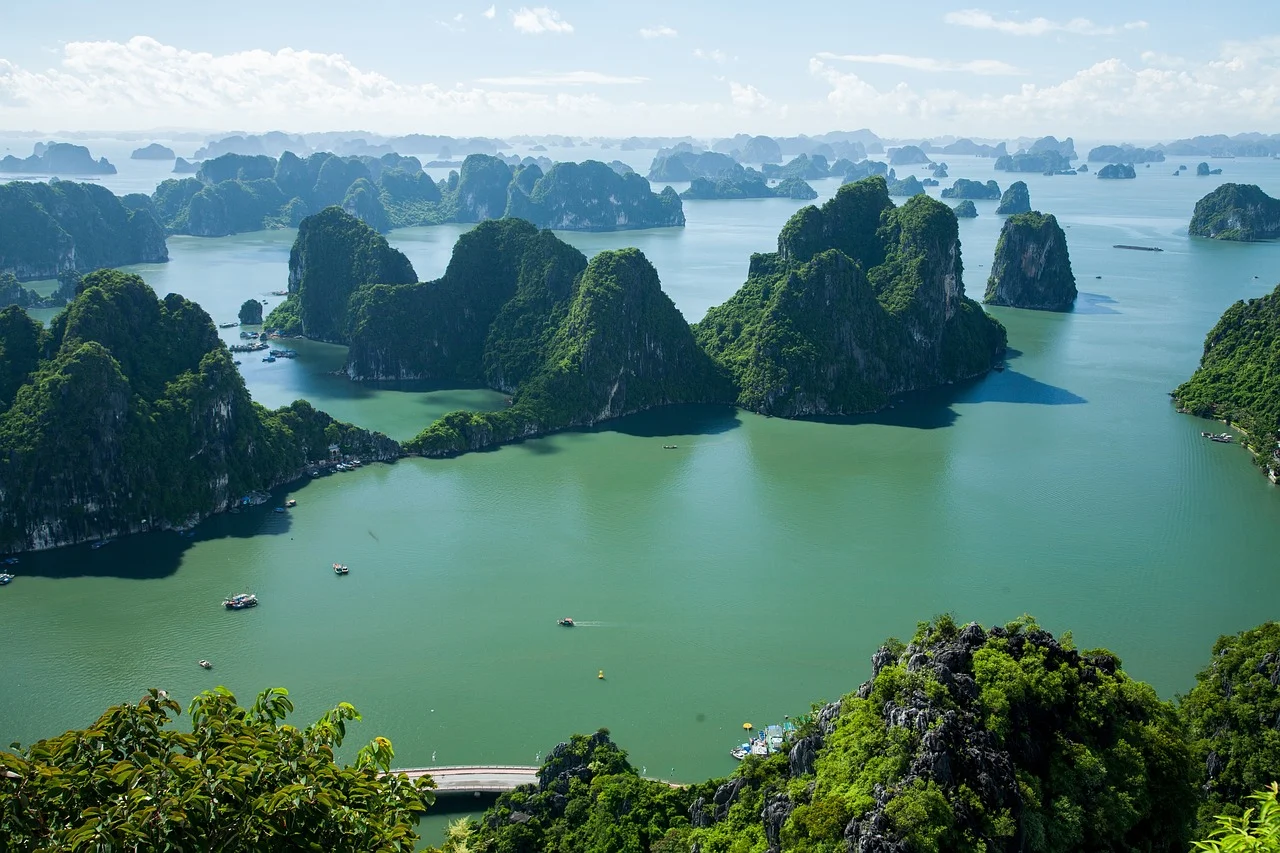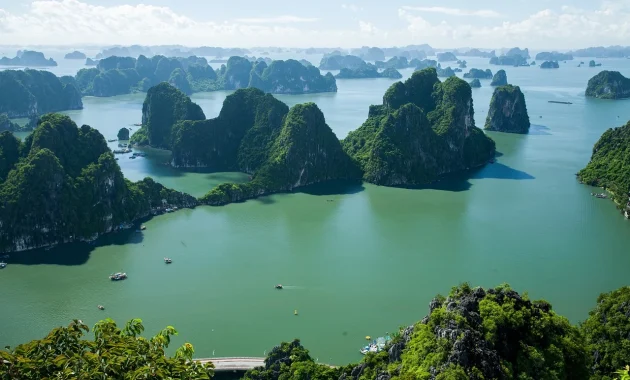
Nestled in the northeastern region of Vietnam, Ha Long Bay is one of the world’s most awe-inspiring natural wonders. Recognized as a UNESCO World Heritage site, Ha Long Bay’s striking emerald waters, thousands of towering limestone islands, and unique rock formations make it a must-visit destination for travelers seeking both natural beauty and cultural heritage.
The Legendary History of Ha Long Bay
The name “Ha Long” translates to “descending dragon” in Vietnamese. According to local legend, the bay was created when a family of dragons descended from heaven to protect the land from invaders. The dragons spat out thousands of pearls, which transformed into the jagged islands and islets that today rise dramatically from the water.
But beyond myth, Ha Long Bay has a rich and tangible history. Archaeological studies have uncovered evidence of prehistoric human activity in the area, with some findings dating back to over 20,000 years ago. The bay has also been an important center for trade and commerce throughout Vietnam’s history, playing a crucial role in the country’s maritime routes.
The Geology and Landscape of Ha Long Bay
Ha Long Bay is home to over 1,600 limestone islands and islets, many of which have been shaped by millions of years of geological activity. The islands are made of karst limestone formations, which have been eroded over time by wind and water. This unique erosion process has resulted in the formation of caves, arches, and other stunning natural features.
Among the most famous islands are:
- Cat Ba Island: The largest island in Ha Long Bay, renowned for its biodiversity and rugged landscapes.
- Dau Be Island: Known for its diverse marine life and crystal-clear waters, making it ideal for snorkeling and diving.
- Ga Choi Islet: Often called the “Fighting Cock Islets” because of their distinctive shape resembling two roosters facing off in a duel.
The towering cliffs and hidden lagoons offer an unforgettable backdrop for exploration and discovery. Many of the islands also contain caves, such as Sung Sot Cave (Surprise Cave) and Thien Cung Cave (Heavenly Palace Cave), where visitors can marvel at intricate stalactites and stalagmites.
Flora and Fauna: A Diverse Ecosystem
The biodiversity of Ha Long Bay is remarkable. The bay’s islands are covered in dense vegetation, creating a habitat for a wide variety of plant and animal species. While exploring the bay, visitors may spot:
- Endangered primates, such as the Cat Ba langur, one of the rarest primate species in the world.
- A variety of bird species, including kingfishers, herons, and the majestic white-bellied sea eagle.
- Marine life ranging from vibrant coral reefs to dolphins, turtles, and even the occasional dugong.
The surrounding waters are equally rich in life, with more than 200 species of fish and over 450 different types of mollusks. This diverse marine environment makes Ha Long Bay a popular destination for eco-tourism, snorkeling, and diving.
Activities in Ha Long Bay
Visitors to Ha Long Bay can partake in a range of activities that allow them to fully experience the beauty and culture of the area:
Cruising Through Ha Long Bay
One of the best ways to explore Ha Long Bay is by boat. A cruise offers the chance to glide past towering cliffs, hidden coves, and floating fishing villages. Several types of cruises are available, from luxury multi-day tours to day trips on traditional junk boats. Some cruises also include on-board activities such as kayaking, squid fishing, and tai chi lessons at sunrise.

Kayaking and Water Sports
For those looking for a more hands-on adventure, kayaking through the bay’s tranquil waters is a must. Paddling between towering limestone formations and exploring hidden caves and lagoons provides a unique perspective on the bay’s natural beauty. Some popular kayaking spots include Luon Cave and Ba Trai Dao Islets.
Visiting Floating Villages
Another unique feature of Ha Long Bay is its floating fishing villages. These communities, such as Cua Van and Vung Vieng, have lived on the water for centuries, maintaining traditional ways of life. Visitors can tour the villages, interact with local fishermen, and learn about traditional fishing practices and village customs. This cultural immersion adds a rich layer to the Ha Long Bay experience.
Exploring the Islands and Caves
Ha Long Bay’s islands and caves offer plenty of opportunities for adventure. Some caves, like Sung Sot Cave, are known for their impressive size and stunning rock formations, while others, such as Thien Cung Cave, are famous for their intricate designs and vibrant stalactites. Guided tours often provide insightful information on the geology and history of these natural wonders.
Best Time to Visit Ha Long Bay
The best time to visit Ha Long Bay is from October to April, during the cooler, drier months. The weather during this period is more temperate, with clear skies and calm waters, perfect for outdoor activities. However, the bay can be visited year-round, with the summer months offering warmer temperatures and the occasional rain shower.
For those interested in avoiding crowds, the shoulder seasons of March to April and September to October provide an ideal balance of good weather and fewer tourists.
Preserving Ha Long Bay’s Natural Beauty
As one of Vietnam’s most popular tourist destinations, efforts are being made to preserve Ha Long Bay’s fragile ecosystem. Local authorities have introduced sustainability initiatives to limit the environmental impact of tourism, such as regulating the number of boats in the bay and promoting eco-friendly practices among visitors. Additionally, UNESCO has worked closely with Vietnamese authorities to monitor the bay’s environmental health and ensure that it remains a natural wonder for future generations.
Tourists are encouraged to be mindful of their environmental footprint, avoiding littering and respecting local wildlife. Supporting responsible tour operators and choosing eco-friendly activities can help preserve the bay’s beauty for years to come.
Conclusion: Why Ha Long Bay Is a Must-Visit Destination
With its mesmerizing landscapes, rich biodiversity, and deep cultural history, Ha Long Bay stands as one of the most extraordinary natural wonders in the world. Whether you’re cruising between its towering limestone islands, exploring its hidden caves, or immersing yourself in the local culture of its floating villages, Ha Long Bay offers an experience unlike any other. It is a destination that blends adventure, relaxation, and education, making it perfect for every type of traveler.